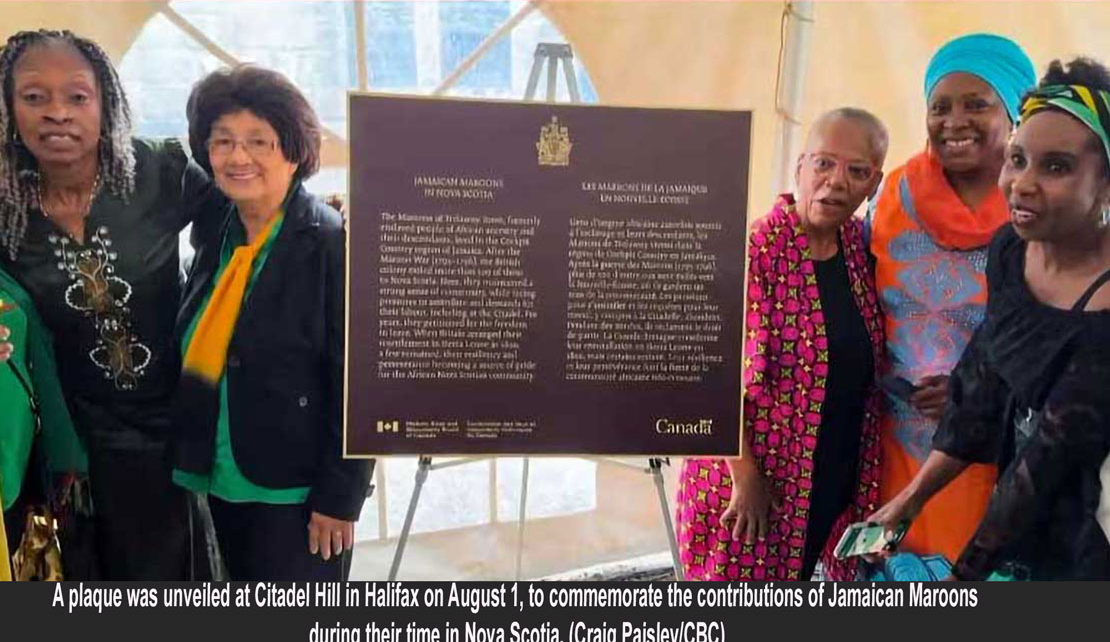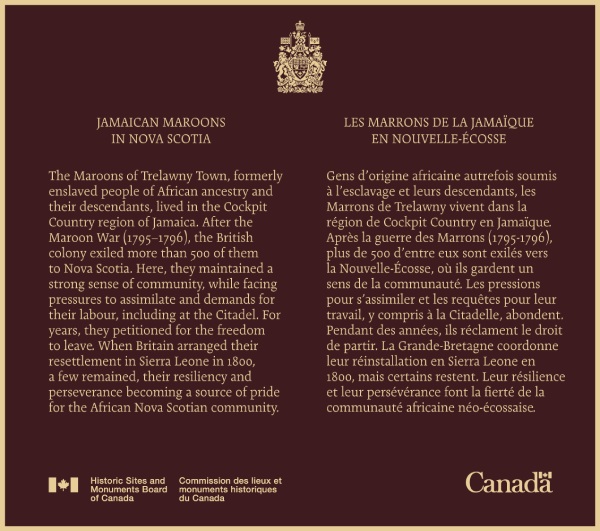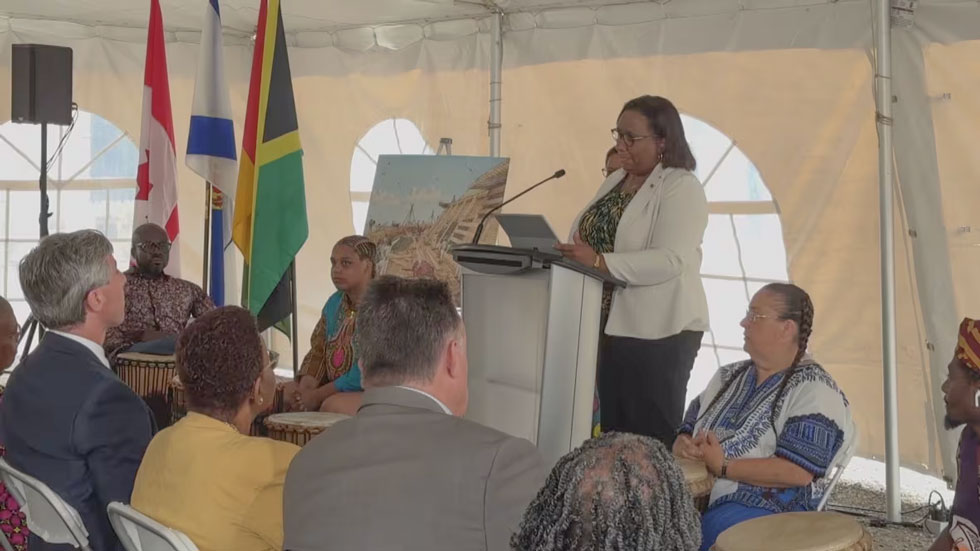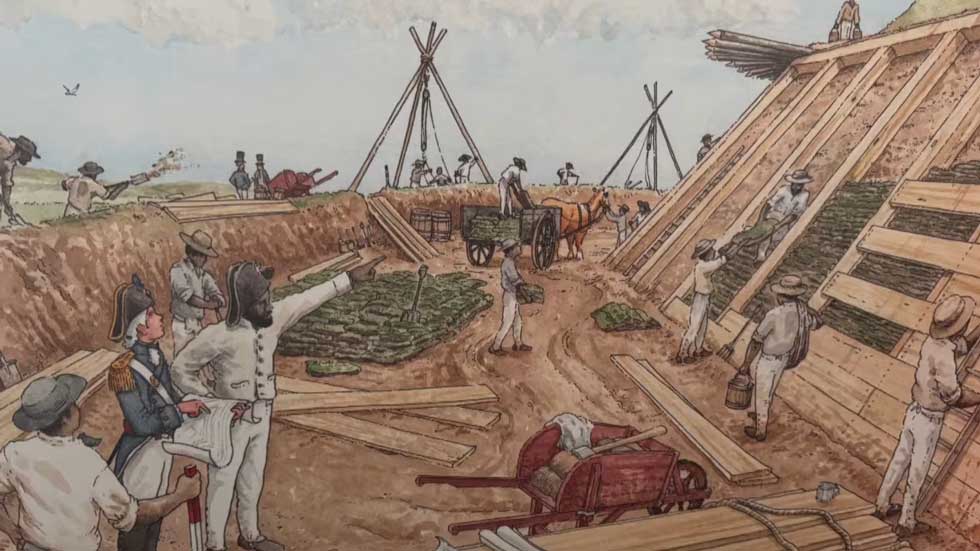DIASPORA | Honouring the Jamaican Maroons in Nova Scotia: Their Contributions and Legacy

HALIFAX, Nova Scotia, Parks Canada - Aug. 2, 2024 - On Emancipation Day, August 1, 2024, the Canadian Government commemorated the national historic significance of the Jamaican Maroons in Nova Scotia with a plaque unveiling ceremony at the Halifax Citadel National Historic Site.
This event, announced on behalf of Minister of Environment and Climate Change and Minister responsible for Parks Canada, Steven Guilbeault, coincided with Emancipation Day and was effected by Lena Metlege Diab, Member of Parliament for Halifax West.
Historical Background

On 21 and 22 July 1796, three British war schooners, the Dover, Mary and Ann with their cargo of 600 Maroon men, women and children landed in Halifax Harbour. The government of Nova Scotia was left to determine their future. Prince Edward Augustus (later Duke of Kent), who had reviewed the Maroon men on shipboard, employed them to work on his refortification of Citadel Hill (see Halifax Citadel). Eventually, with the permission of the British authorities, Governor Wentworth decided to settle the Maroons in Nova Scotia.
Some of the land and farms that had been left vacant by the emigration of the Black Loyalists in 1792 were available in Preston (see also Black Canadians). Additional houses were built, a schoolmaster and clergyman employed, provisions were provided, and the Maroons were expected to become peaceful farmers.
In acknowledgement of the Maroons’ military reputation, and because the government feared a French invasion, the Maroons were organized into a militia company. Their officers were among the leaders of the 1795 rebellion in Jamaica and all were battle-hardened.
The Maroons of Trelawny Town were formerly enslaved peoples of African ancestry and their descendants who had lived in the Cockpit Country region of Jamaica until their exile following the second and final Maroon War (1795–1796). Almost everyone from the town were forcibly transported to Nova Scotia. Many people became sick and several died during the voyage
Significant Contributions to Nova Scotia's Infrastructure

- Construction of roads and highways
- Building of canals and bridges
- Erection of various buildings
- Development of fortifications, including significant work on the third fortification on Citadel Hill in Halifax
The Maroons' labor was particularly important in the construction of the Halifax Citadel, which later became a national historic site. Their contributions were so substantial that the Halifax Citadel National Historic Site was chosen as the location for the commemorative plaque.
Relocation to Sierra Leone
For years, the Maroons tirelessly petitioned for the freedom to leave Nova Scotia. In the end, the British arranged for their migration to Sierra Leone, where 1,196 Black Loyalists from Nova Scotia and New Brunswick had been resettled in 1792. Given the choice, the Maroons would have rather returned to the mountains of northwestern Jamaica. In the end, however, some 177 women, 151 men, and 222 children were aboard the transport ship HMS Asia when it anchored off the coast of Freetown on 30 September 1800.
A small number of Jamaican Maroons remained in Nova Scotia after 1800. The pride, resistance, self-determination, and unique cultural identity of the Maroons gained new significance in the second half of the 20th century within the contexts of social movements for greater civil rights and recognition of the diverse histories, cultures, and achievements of African-descended peoples. Today, the historical presence of the Jamaican Maroons still holds a prominent place within the collective memory of African Nova Scotians.
Despite their significant contributions, the Maroons faced ongoing challenges and tirelessly petitioned for the freedom to leave Nova Scotia. After years of persistence, the British government arranged for their migration to Sierra Leone. This relocation was extensive:
- On September 30, 1800, the HMS Asia anchored off the coast of Freetown, Sierra Leone
- 550 Maroons were aboard: 177 women, 151 men, and 222 children
It's important to note that while a large number were relocated, a small group of Jamaican Maroons chose to remain in Nova Scotia, continuing their legacy in the province.
Lasting Impact and Recognition

Though the experience of the Maroon settlement in Nova Scotia was brief and lasted only four years … their legacy remains one of a proud, defiant and resilient group," she said.
"By acknowledging the contributions of our ancestors, including the Jamaican Maroons and other groups … we not only honour their memory, but we are also educating and building awareness among current and future generations about the importance of diversity, resilience, community and the wider process of nation building, " the Jamaican High Commissioner said.
The pride, resistance, self-determination, and unique cultural identity of the Maroons gained new significance in the latter half of the 20th century, particularly within the context of civil rights movements and recognition of African-descended peoples' diverse histories and achievements.

The Government of Canada's commemoration, through the Historic Sites and Monuments Board of Canada, recognizes the Maroons' importance in shaping the country. This designation is part of over 2,240 nationwide, helping Canadians connect with their diverse history and heritage.
The plaque unveiling ceremony was part of a larger collaborative event, involving:
- The Office of African Nova Scotian Affairs
- The Canadian Museum of Immigration at Pier 21
- The Black Cultural Centre for Nova Scotia
- The Jamaican Cultural Association of Nova Scotia
This commemoration serves not only to honor the Jamaican Maroons but also to highlight their crucial role in building Nova Scotia's infrastructure and their enduring legacy in Canadian history. The six hundred men, women and children from Trelawny Town, while in Nova Scotia, struggled tomaintain their custom, kinship ties,and their social and political independence. Attempts by Governor John Wentworth and the Maroon Superintendents to establish permanent communities were thwarted. by racial and cultural tensions including outright hostility and a "don't care" attitude by the British and Nova Scotia authorities.
Jamaican author Horane Smith in his book "Marooned in Nova Scotia" wrote a story about the Jamaican Maroons in Canada, while John N. Grant as part of his research, in 2002 published his account of "The Maroons in Nova Scotia" to coincide with the 200th anniversary of the Maroon Migration from Nova Scotia.
-30-
